Burçak Bingöl’s ‘Interrupted Halfway Through’ at Zilberman Gallery Berlin
by Lotte Laub
“Si les choses de l’art commencent souvent au rebours des choses de la vie, c’est que l’image, mieux que toute autre chose, probablement, manifeste cet état de survivance qui n’appartient ni à la vie tout à fait, ni à la mort tout à fait, mais à un genre d’état aussi paradoxal que celui des spectres qui, sans relâche, mettent du dedans notre mémoire en mouvement. L’image serait à penser comme une cendre vivante.”[1]
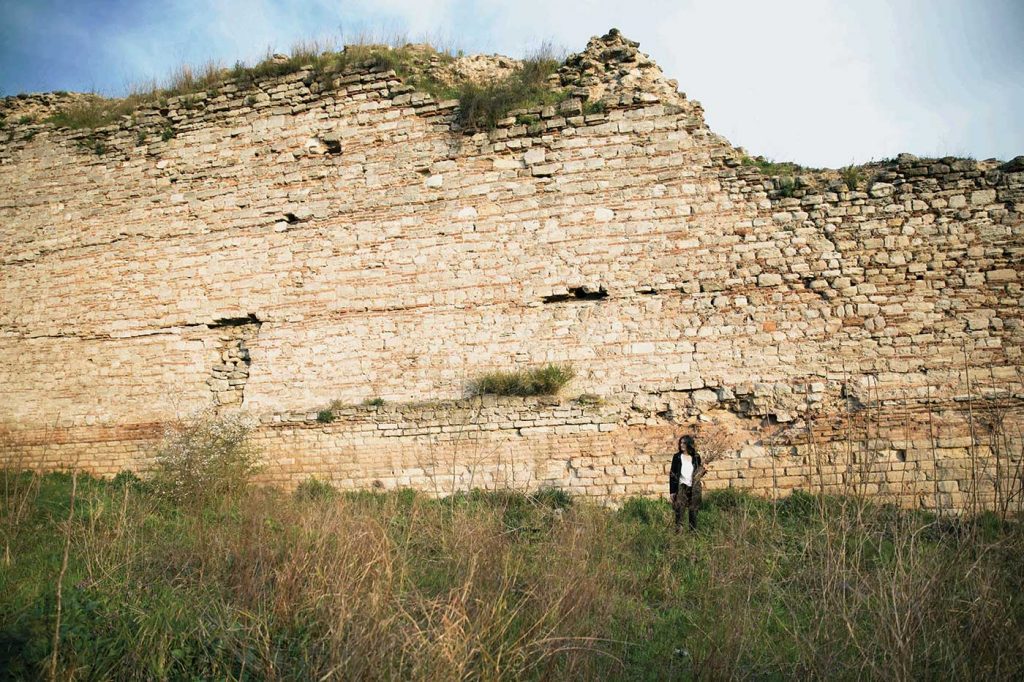
Courtesy: Burçak Bingöl and Zilberman Gallery, Istanbul/Berlin. photo: Nazlı Erdemirel
If the things of art often start contrarily to the things of life, it is because the image, probably better than anything else, manifests this state of survival that belongs neither completely to life, nor completely to death, but to a kind of state as paradoxical as that of the spectres that are relentlessly setting our memory in motion from within. The image is to be thought of as living ash.[2]
It is paradoxically the things that no longer exist, that have ended irretrievably, that set our memory in motion. In her first solo exhibition in Berlin – Interrupted Halfway Through, a citation from the chapter on Istanbul in the collection of essays Beş Şehir (1946, Five Cities) by Ahmet Hamdi Tanpınar (1901–1962) – Burçak Bingöl deals with individual and collective memory, its materialisations and unreliabilities. Ekrem Işin also quotes the metaphor in his contribution to Bingöl’s catalogue for the 2017 Mythos und Utopia exhibition at the Istanbul location of Zilberman Gallery:
“This journey of myths that has transformed into a spectacle is not unfamiliar to people of a society who have been struggling – for two hundred years – to keep on their feet living on the east-west fault line with joints cracking as if about to shatter at any moment. Swept by utopia into attics, storage rooms or under the stairs, mythos’ traditional heritage, though occasionally, emerges from its hideout and roams around; sometimes shyly, other times menacingly. Let’s not forget: every time the cultural fault line on which we attempt to establish our habitat becomes active, life experiences, ‘interrupted halfway through’ (as Tanpınar used to say), meet each other in the dump site cohabited by mythos and utopia.”[3]
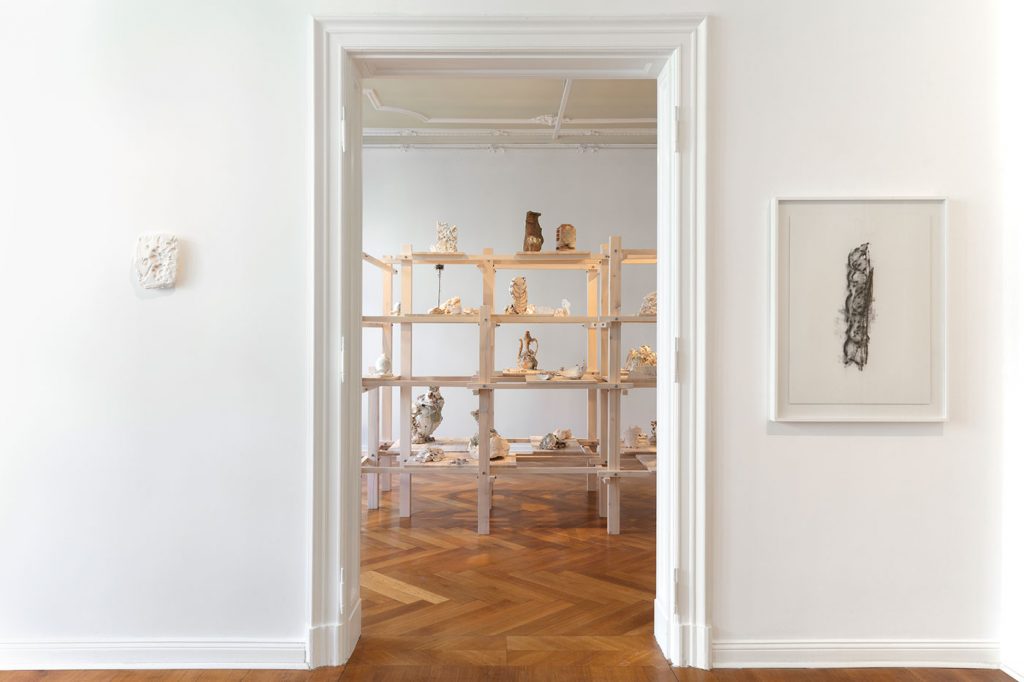
Burçak Bingöl: Interrupted Halfway Through, Zilberman Gallery Berlin, April 25 – July 27, 2019., Courtesy: Burçak Bingöl and Zilberman Gallery, Istanbul/Berlin. photo: Chroma
Burçak Bingöl, who lives in Istanbul, has taken a close look at this fast-growing, rapidly changing city. In the midst of all the transformation, her focus is on traces of the past: she gathers cobblestones, stucco, wallpaper, shards and plants that are sprouting from ruins or abandoned streets. She puts these objects together or fires them into conglomerates in a ceramic process. Bingöl is in a sense interrupting the decay of the relics halfway through, in order to give these objects – like archaeological findings – an opportunity to extend into the future.
The centrepiece of the exhibition, the installation Cargo in the middle room, is a scaffold-like rack full of ceramics that, according to the artist, appear as if they have been rescued from the belly of a shipwreck: Interrupted Halfway Through, a shipwreck halfway through sinking. The configuration of the installation evokes the storage area of an archaeological museum.
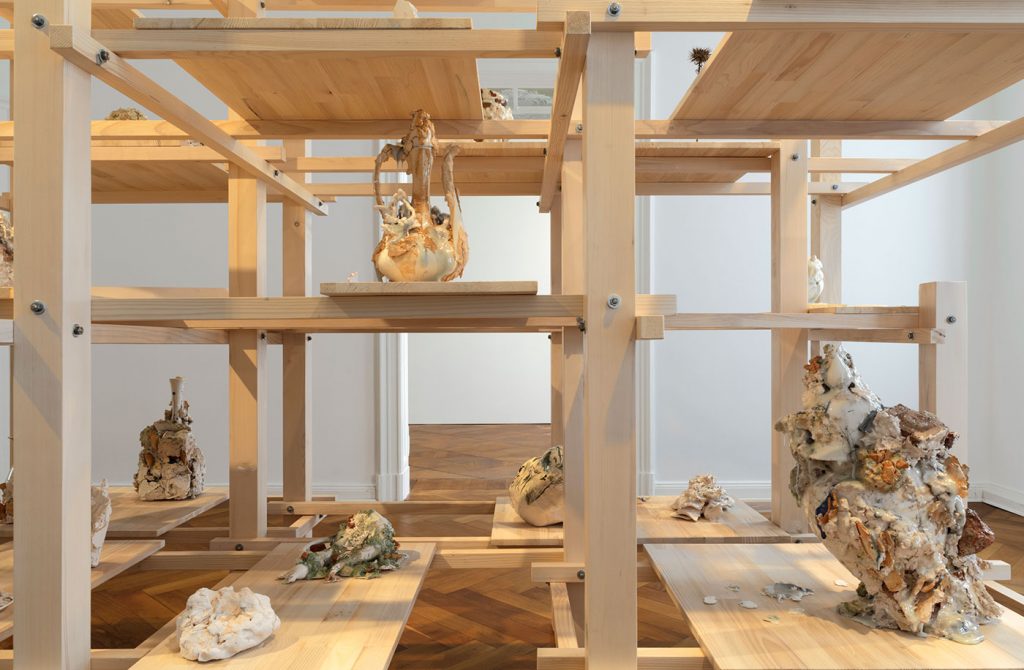
Burçak Bingöl: Interrupted Halfway Through, Zilberman Gallery Berlin, April 25 – July 27, 2019., Courtesy: Burçak Bingöl and Zilberman Gallery, Istanbul/Berlin. photo: Chroma
Ceramics are at the centre of Bingöl’s work, experimenting at the divide between control and chance. She incorporates thorny stems or grasses into her ceramic work, or she uses digitalised images of plants – like miniature paintings at the Topkapı Palace – and transfers them to the broken edges of shards. She puts self-produced and found porcelain objects – often fragments – together and combines them with unformed, unfired clay. She then fires the new conglomerate and leaves the glazes to run over the unshaped mass, in doing so implying incompleteness, chance and error, and gaps in which new carriers of meaning emerge. Old has an impact on new, tradition influences future, the present influences our understanding of the past. The result is hybrid forms between dissolution and taking shape, between drying and liquefaction, and forms that have solidified while taking shape. It is construction with fragments, such as fractures, discontinuities and changes of material (ceramic, brick, glaze, cement, stone, plants), but the construction is never complete, a whole is never created. The fragment points to the notion of whole as a myth, or a utopia. Sometimes it is clumps of clay partially covering the fine fragments of a vase. Cut edges show the stratifications of vase and clay like a geological profile. In many creation myths, clay is the material used by the creator to form humans: the clay artist as the archaic archetype of God the Creator. In Jewish mysticism, there is the story of the shattering of the vessels in the world-creation process, the task since then being to restore these vessels to their original wholeness.
Bingöl’s work Leftover – Avanos (2019), named after the pottery village in Cappadocia, depicts a creation process interrupted halfway through. The sculpture Pile up (2019), the result of complex processing and multiple firings, shows a vertical cut through terra cotta bowls that have been stacked on top of each other with clay in between them; glaze flows down from an upper layer and the structured cut surface calls to mind the lines on a leaf. In the ceramic fragments that Bingöl uses, the viewer’s attention is drawn to a whole that originally existed, or to one that is not yet complete.[4] If the fragment can be considered in both directions, as broken as well as unfinished, then it is indicative of a melancholic attitude. Another work, Ground Sample (2019), is based on a found, cylinder-shaped piece of a brick structure. Bingöl was a guest of the Zilberman Gallery’s artist-in-residence programme in Berlin last summer. She looked intensively at the gallery rooms but also at the urban space and the remembrance culture that she misses in Istanbul. Ground Sample (2019) may also evoke the façade of Berlin’s modern Memorial Church; next to it, Bingöl has placed the work Leftover – Line (2019), which in turn calls to mind the remaining church fragment that itself serves as a memorial to World War II.
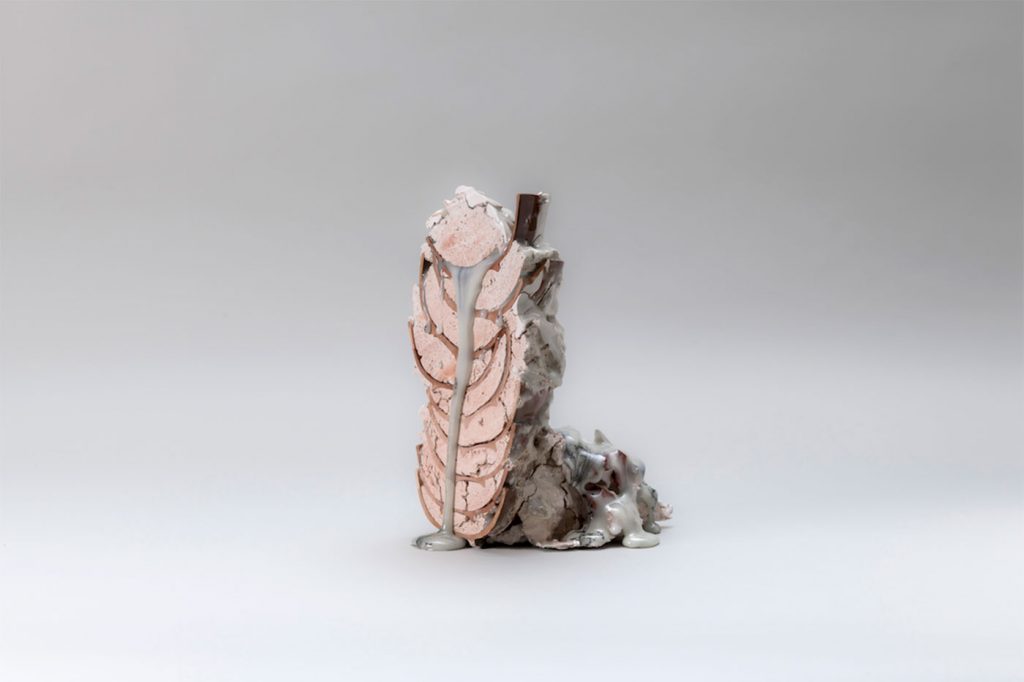
Burçak Bingöl: Pile up, 2019, glazed ceramics, 22 x 18 x 28 cm.
Courtesy: Burçak Bingöl and Zilberman Gallery, Istanbul/Berlin. photo: Kayhan Kaygusuz
In the first room of the exhibition, Bingöl is showing her work Displaced Gallery Wall Or a Fragmented Memory Of a Rose (2017), a wall piece from her previous exhibition Mythos and Utopia in Istanbul where the rose motif – from the Topkapı Palace – was applied directly onto the gallery wall with clay. The artist had the motif cut out of the wall after the exhibition closed and Bingöl has now brought the work to Berlin. Her previous exhibitions as well as the current one can be imagined as flowing passageways and simultaneously as a stoppage of time. The city of Istanbul – with its epochs of history and one-time status as the cultural centre of a major empire – was a hub of international trade and part of the ancient Silk Road. A loss of significance since the previous century means the past continues to be present. And it is precisely the visibility of what has disappeared and what is disappearing that creates a particular sense of the ephemeral, a melancholic mood or hüzün that Orhan Pamuk describes in his portrait Istanbul: Memories and the City. Like an archaeologist, Bingöl examines the many historical layers, a texture composed of innumerable disintegrating elements of the kind she has captured in two frottages she has created for her Berlin exhibition. The rubbings show ornamental motifs on the Tophane Fountain that was built in 1732 under Sultan Mahmut I; all the surrounding shops were torn down to keep the square free and showcase the construction. Today, the fountain is a scattered historical element in the urban palimpsest whose ornamentation is indicative of the metropolis’ former splendour. Bingöl is also exhibiting two clay impressions, one again from the Tophane Fountain and another from a stucco element in the gallery space in Berlin. Bingöl works with fragments that she layers on top of each other and thus creating a superimposition of the gallery spaces in Istanbul and Berlin, both cities and different periods – the fountain from the Ottoman era, the gallery spaces in Istanbul and Berlin from the turn of the century, and the clay impressions and frottages from today.
In the third room, the exhibition has an installation featuring cobblestones from Istanbul and a sound installation. Bingöl found the old granite cobblestones on the ground at a construction site on one of the old streets of the Galata district where her atelier is located. She was able to save some of them before they were covered with asphalt. She is also exhibiting dried plants, weeds and thorny plants that she collected along Istanbul’s old city wall and has mounted on the gallery wall with clay.
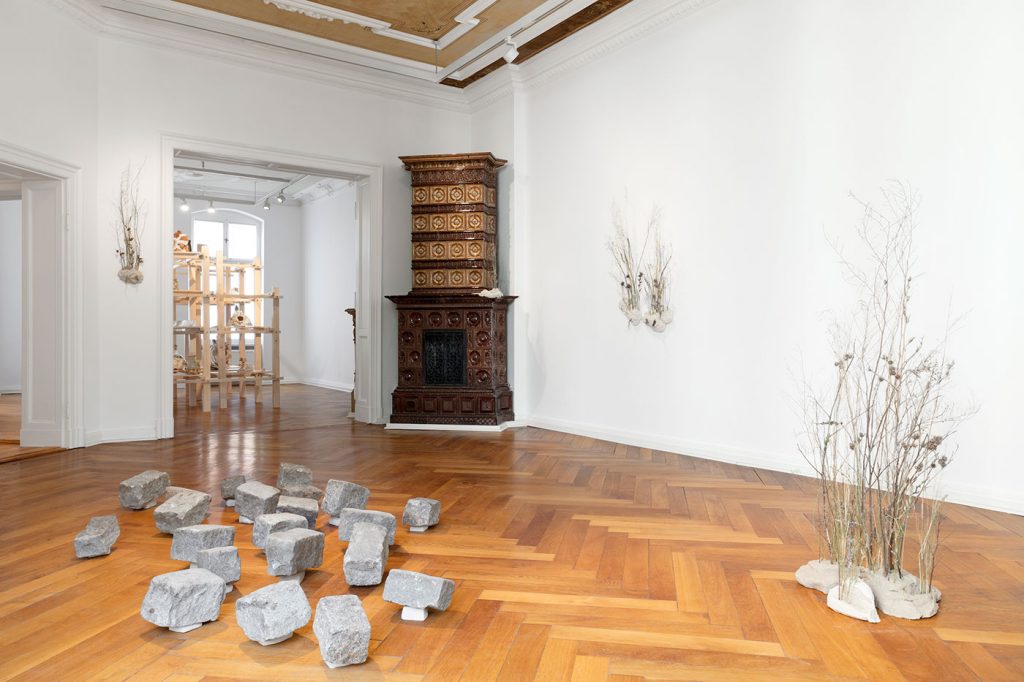
Burçak Bingöl: Interrupted Halfway Through, Zilberman Gallery Berlin, April 25 – July 27, 2019., Courtesy: Burçak Bingöl and Zilberman Gallery, Istanbul/Berlin. photo: Chroma
For the sound installation, which visitors listen to via headphones, Bingöl recorded her own footsteps on the old, creaky parquet flooring in the gallery. Similar to an autobiography, the steps refer to two different time domains that cannot be aligned. Georges Didi-Huberman compares the afterlife of a footprint with the “phantom-like effect of spirits”: “[…] the coinciding of a there and a not there, of contact and absence. The fact that the imprint is in this sense the contact of absence is explained by the lasting power of its relationship to time, which corresponds to the phantom-like effect of ‘spirits’, of an afterlife: of something that has gone and yet stays with us, stays close to us, in order to give us a sign of its presence.”[5]
Faced with all these objects that have been saved before their final disappearance, visitors to the exhibition are themselves challenged to try and imagine the fragments as part of a bigger context, but even these attempts will get stuck halfway: the whole will remain either a myth or a utopia.
Ahmet Hamdi Tanpınar’s proverbial lines, “I am neither inside time, nor completely outside of it” can be used in reference to Burçak Bingöl’s exhibition, as can the end of Tanpinar’s chapter on Istanbul:
“So many memories, so many people. In discussing Istanbul and the Bosporus, why have I evoked everything so impossible to resurrect? Why are we drawn to time past as to an empty well? […] No, my search is not for past time nor for those who lived in it. […] If they existed today, we would feel ourselves richer in a different way but we would never know the emotion that their absence stirs in us.”[6]
[1] Georges Didi-Huberman: Génie du non-lieu. Air, poussière, empreine, hantise (sur Claude Parmeggiani), Paris: Minuit, 2001, p. 16.
[2] Translated from French by the translator.
[3] Ekrem Işin: Mythos and Utopia. The Spiraling Reality of a Pair of Phenomena, in: Burçak Bingöl: Mitos ve Ütopya. Mythos and Utopia, exhibition catalogue. Zilberman Gallery, p. 8.
[4] Cf. Eberhard Ostermann: Das Fragment. Geschichte einer ästhetischen Idee, Wilhelm Fink: Munich, 1991, p. 13.
[5] Georges Didi-Huberman: Ähnlichkeit und Berührung. Archäologie, Anachronismus und Modernität des Abdrucks (original ed.: L’empreinte , Paris 1997), translated from the French by Christoph Hollender, Cologne: DuMont, 1999, p. 26. From the German by the translator.
[6] Ahmet Hamdi Tanpınar: Tanpınar’s ‘Five Cities’ (original ed.: Beş Şehir, 1946), translated from the Turkish by Ruth Christie, New York/London: Anthem Press, 2018, pp. 209–210.
This text was published as the introduction of
Burçak Bingöl’s exhibition catalogue, published by Zilberman Gallery and
accompanying Bingöl’s solo show “Interrupted Halfway Through” on view at
Zilberman Gallery – Berlin from April 25 until July 27, 2019. The catalogue
includes contributions by Sevinç Çalhanoğlu, Lotte Laub, Wendy Shaw and Simon
Wachsmuth. An extension of the exhibition, “Living Inside a Tale And There Only”,
is on view at Zilberman Gallery – Istanbul from May 14 until July 5, 2019.

